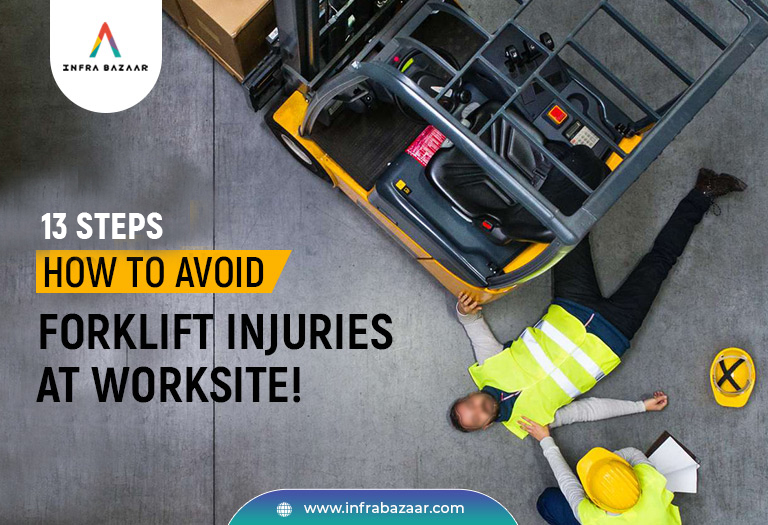
Posted By: Infra Bazaar
Forklifts are commonplace equipment at worksites to lift and transport loads and goods with precision. They are very powerful and make your work easy however they need to be manned with care to avoid any injuries. Infrabazaar discusses how it is essential to not only be aware of operating the forklift well but also train your colleagues in its usage.
High-level equipment tends to be operated with alertness, and general awareness of their usage goes a long way in keeping the worksite safe.
It is important to note that not every worker will have the same level of safety awareness and understanding to operate a forklift and hence it's essential to roll out a complete guide to operate and work alongside the equipment where a forklift is stationed.
1. Acquire adequate knowledge of what a forklift does
It is important to first really be aware of what a forklift does and how it functions to be able to raise awareness of its possible hazards as well. Everyone needs to be on point with the understanding of this equipment's functions to prevent any mishap. The equipment guide videos, demonstrations, and software knowledge are essential here as a possible guide for everyone.
2. Wear adequate gear
Forklift operators should be dressed in appropriate safety gear including safety shoes, hard hats, and high visibility jackets to man the equipment.
3. Know your equipment well
One should know the forklift type and classification to be aware of the equipment they are handling. This also prepares one to follow adequate safety practices accordingly.
4. Daily equipment inspection
The forklifts need to be examined before and after every use. There is generally a very standard operating procedure of key checks to do before and after use, which include:
Key procedures like brakes, lights, horns, wheels, and lights.
Mast and overhead guard review to review the damage
Tire and fluid levels
Reporting leaks if any in oil, water, radiator
Reviewing if forks are working fine
Any irregular machine operating process needs to be flagged
Any aberrations in its working or defects need to be logged in the system or reported to superiors without fail. Faulty equipment shouldn’t be operated.
You should thoroughly inspect forklifts before every use. Daily checks with the shift supervisor are recommended to identify and log any problems or defects. Any equipment that requires repair should never be operated.
5. Maintaining 360° visibility is a must
Forks often end up coming in the way while operating a forklift, and hence they should be maintained at a low height to pave way for adequate visibility. Always make it a point to have a clear view of the load, and when the load is huge, use the equipment in reverse. A few things to keep in mind here:
Make eye contact with other workers
Always look ahead
Use rear-view mirrors
Use headlights if operating the equipment at night or outdoors, use extra lighting if needed
6. Follow a floor plan
A floor marking system marks the key working areas for the workers to ensure their safety and also for smooth functioning on the production floor. Please use yellow to mark areas which could be physical hazards, such as areas which ate slippery and red to call out areas which could catch fire, call out fire equipment and emergency switches. Place way signs throughout the site to keep people away from forklift paths, lead forklifts along safe routes, and improve the overall flow of traffic. A key success of a floor plan is also when it is clearly communicated to workers and they follow it clearly.
7. Maintain equipment capacity
Always carry loads within the capacity and never exceed the weight limits. Overloading can lead to accidents and equipment failure as well
8. One man equipment handling
Only one person is allowed to operate a forklift and don’t overload it to avoid any mishaps.
9. Keep the Forklift stable at all times
Keep the forklift stable while working. Here are some steps you need to take care of:
Keep your hands and shoes dry while operating the lift
Keep controls of the equipment within your reach
Don't be distracted while using the equipment
Sit properly while using the equipment
Don't overload the equipment and use it as per instructions
Don't defy the centre of gravity of the forklift
10. Use stable loads
Use loads which are stable and balance well on the forklift. Carry load tiled backward and keep forks low for adequate visibility while operating the forklift.Use ropes and bindings whenever necessary.
11. Drive the forklift at an adequate speed
Always use the forklift at an adequate speed. Never rush or move it quickly as the chances of toppling are very high and can lead to serious injuries.
12. Mind your distance with a forklift
It is important to be within a safe distance of a forklift considering that these are heavy-duty equipment.
13. Station your lift at the right place
It is essential to park the equipment at the designated area with adequate spacing, and forks tilted down.
It is essential to follow these steps to optimise production whilst staying safe!
#forkliftsafety #worksitesafety #equipmentsafety #forkliftguide #forkliftoperation #injuryfree